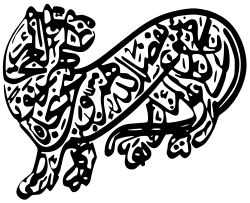Murād Mīrzā
Murād Mīrzā (Arabic: مراد ميرزا; 1509-1514?-1574) was the 36th Imam of the Nizari Ismaili Shia Islam community.
Life
He was a politically active Imam, possibly alongside the Nuqtavi Shia group, and had a large following.[1] Murād Mīrzā did not always operate from the Nizari base of Anjudan. As a result of his activeness, he acquired followers in Kashan and other central Persian areas. Ali Shah, surnamed Shah Murad or Murad Mirza lived in Anjudan. He had also retained his close relations with Shah Ismail cemented by his father. His mode of living, his dress and food were characterised by a rare simplicity.
The Ottoman sultan Salim (1512-1520) began his long march to northern Azerbaijan after putting 40,000 Shias to death in his dominions. He reached the plain of Chaldiran and the outbreak of war occurred in 920/1514. He inflicted a defeat to Shah Ismail. The Ottoman firepower, consisting of 200 cannon and 100 mortars was brought into play with devastating effect. After suffering heavy casualties, the Safavid artilleries were forced to break off the engagement. When Shah Ismail left the battlefield, sultan Salim did not pursue him. Later, he marched to Tabriz, the Safavid capital, which he occupied in 922/1517. Caterino Zeno, the Venetian ambassador writes in "Travels in Persia" (p. 61) that, "If the Turk had been beaten in the battle of Chaldiran, the power of Ismail would have become greater than that of Tamerlane, as by the fame alone of such a victory he would have made himself absolute lord of the East." Later, the Mamluks of Syria and Egypt similarly remained wedded to their cavalry, and were also defeated by the Ottomans.
The effect of the Safavid defeat at Chaldiran was the loss of the province of Diyar Bakr, which was annexed to the Ottoman empire in 921/1516. Shah Ismail went into mourning after his defeat. During the remaining ten years of his reign, he never once led his troops into action in person. He did not devote his attention to the affairs of the state as in the past. On the contrary, he seems to have tried to drown his sorrows by wine. His abdication of his responsibilities in regard to the personal direction of the affairs of state gave certain officials the opportunity to increase their own power. The clash between the Kizilbash and the Iranian soldiers began to be a threat to the Safavid kingdom.
Kizilbash were the Turkomans, who were distinguished for wearing red pointed caps, which they had begun to wear in the time of Shaikh Hyder (1456- 1488), the father of Shah Ismail; and thus they became known as Kizil-Bash (red heads), and in its Iranian form, Qizilbash, or Red Heads. They shaved their beards but let their moustaches grow. The Kizilbash constituted the backbone of the Safavid army. It seems probable on that juncture that Shah Ismail had generated a close tie with the Ismaili Imams in Anjudan, and granted them the title of Amir al-Umra. There is its another reason that the Ismailis had joined the Safavid army in Khorasan, who had repulsed the aggressive advance of the Uzbeks in 916/1510. Shah Ismail had most possibly planned to seek the martial aids from the Khorasani Ismaili warriors to crush the uprising in his military if required. He therefore, maintained cordial relation with the Imams of Anjudan. Shah Ismail however died in 930/1524.
It is said that the Muharram was an ideal month for the Ismaili pilgrims visiting Anjudan. They carried usually a small taziyah (replica of Imam Hussain's tomb), and placed it in front of the caravan and passed through the teeth of the bitterest and aggressive places in the Shiite garbs. They put the taziyah at the entrance of Anjudan, and took it again while leaving the town.
Imam Murad Mirza died in 920/1574 in Anjudan and was succeeded by his son Zulfikar Ali.
Capture and execution
In 1573, due to the threat posed by the Imam, the 2nd Safavid monarch, Shah Tahmasp, ordered the governor of Hamadan, Amir Khan Musilu, to go to Anjudan to capture Murad Mirza. Amir Khan proceeded to Anjudan, and while killing a large number of the Imam's followers and taking much booty, was unable to capture him. However, the Imam was soon captured and imprisoned, but again escaped, this time with the aid of a sympathetic high-ranking Safavid official named Muhammad Muqim. With the help of his followers, the Imam was able to escape to Kandahar. However, while in Afghanistan, he was once again captured by the Safavids. This time there would be no escape, and after being brought before Shah Tahmasp he was executed alongside Muhammad Muqim in 1574.[2][3][4]
References
- A Short History of the Ismailis: Traditions of a Muslim Community, by Farhad Daftary, page 176.
- The Isma'ilis: Their History and Doctrines, by Farhad Daftary, page 472.
- Historical Dictionary of the Ismailis, by Farhad Daftary, page xxxiii.
- A Short History of the Ismailis: Traditions of a Muslim Community, by Farhad Daftary, page 176.
Murād Mīrzā of the Ahl al-Bayt Clan of the Banu Quraish Born: ? C.E Died: 1574 C.E. | ||
| Shia Islam titles | ||
|---|---|---|
| Preceded by Abū Dharr ‘Alī |
36th Imam of Nizari Ismailism ?–1574 |
Succeeded by Dhū-l-Fiqār ‘Alī |
